2025-10-16
2 Person Yoga Poses: Easy, Medium, & Hard Asanas to Try with a Partner
Nine different yoga poses 2 people can do, ranging from easy to hard. Grab a friend and give them a try!
 954-694-6479
954-694-6479Best 2 Person Yoga Poses for Different Skill Levels
Whether you’re an experienced yogi eager to explore something new or a beginner wanting to try yoga with a friend, partner yoga offers a rewarding experience for everyone. In addition to the benefits of regular yoga practice, 2 person yoga poses give you an opportunity to build trust, communication, and a sense of humor about even the more challenging stretches. Plus, if you’re shaky on some of the more difficult poses, doing them with a partner can help you get your feet wet.
In this blog, we will dive into eight different 2 person yoga poses, ranging from easy to hard, that you might want to try out.
Before You Begin
Before you try out any of these poses, or asanas, we want to make sure you prioritize your safety and wellbeing. Ensure the following before you begin any 2 person yoga pose:
- Be mindful of your health and physical ability. If you have any conditions which could pose a danger during yoga practice, we suggest you avoid the risk.
- Find a room or outdoor space with plenty of open area to practice in. Have a yoga mat or thick carpet underneath you on a flat surface.
- Don't practice right after a meal. Leave 2–4 hours between meals and yoga practice. It’s also wise to wait around an hour after your practice before eating again.
- Make sure you are well-hydrated by drinking water beforehand, but be careful not to fill up your stomach as it can cause discomfort. Have water nearby in case you feel thirsty or dehydrated during practice, but it is not necessary for you to drink water during yoga practice unless you feel the need to.
- Always warm up before trying any major stretches or difficult poses. If you’re not familiar with good warmups for yoga practice, consider consulting a yoga instructor for help.
2 Person Yoga Poses: Easy Difficulty
The following poses should be relatively straightforward to follow and can be friendly to a variety of skill levels. They provide a nice deep stretch and engage your muscles to build your strength. If you do not have much yoga experience, with a partner or otherwise, we recommend starting with these poses and working your way up based on your comfort level.
Seated Twist
A seated twist can be a great way to stretch the upper and lower back, as well as the chest, shoulders, and neck. There are two main ways to do a seated twist with a partner.
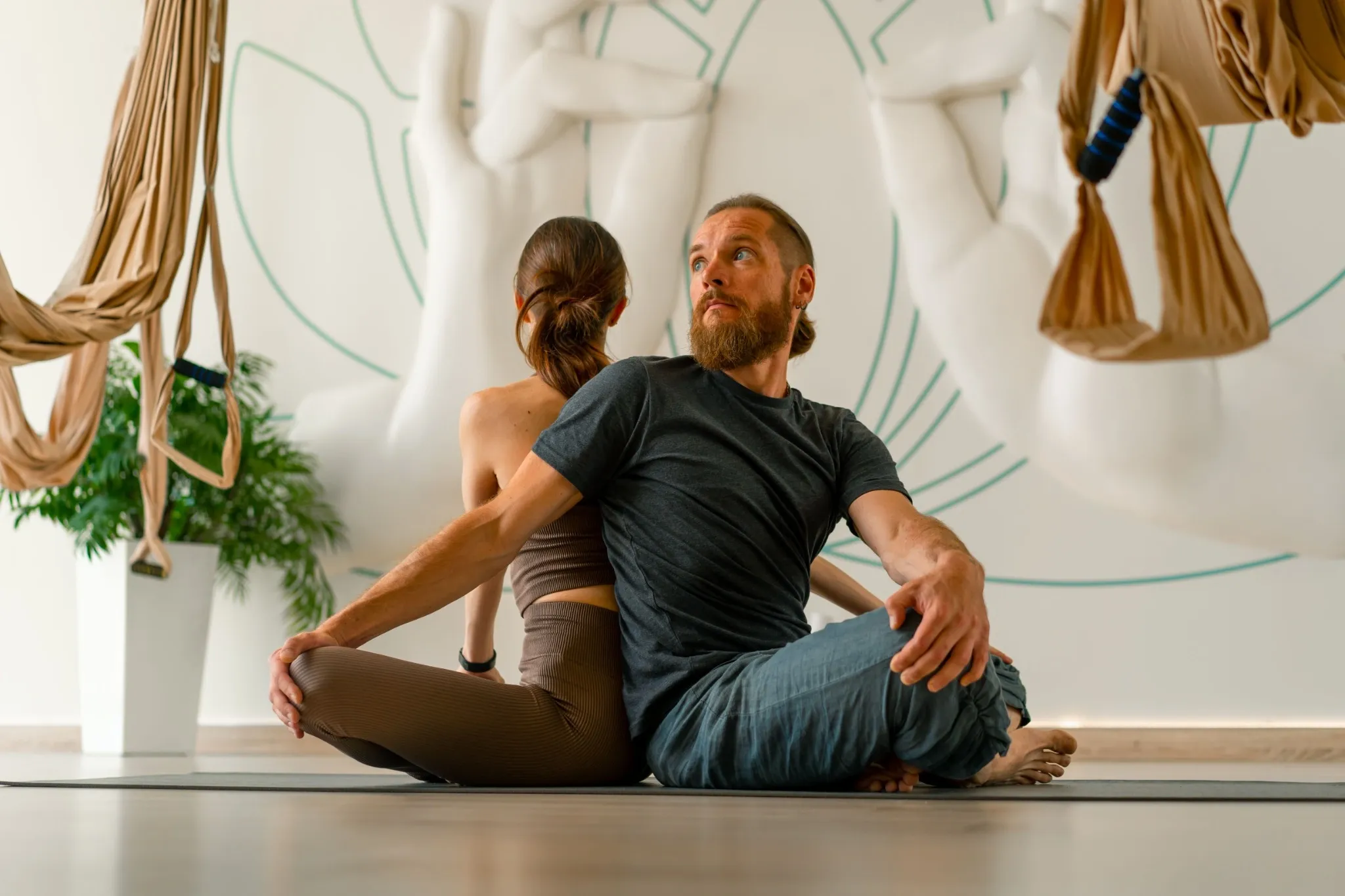
Back-to-Back
- Sit cross-legged, back-to-back with your partner, keeping your backs straight up against each other.
- Inhale deeply and straighten your spine. Use your abdominal muscles to provide support and keep your spine straight.
- Reach back with your left hand to place it on your partner’s right knee. At the same time, your partner should take your right knee with their left hand.
- Keeping your legs in position, both you and your partner twist your upper bodies to your left sides, exhaling as you do so. You can brace your right hand against your left knee for support and to lean into the twist.
- Hold this twist for a few seconds, breathing deeply.
- Release, and slowly rotate back to your starting position.
- From here, you can repeat the twist in the opposite direction, starting by taking your partner’s left knee with your right hand, and twisting to your right.
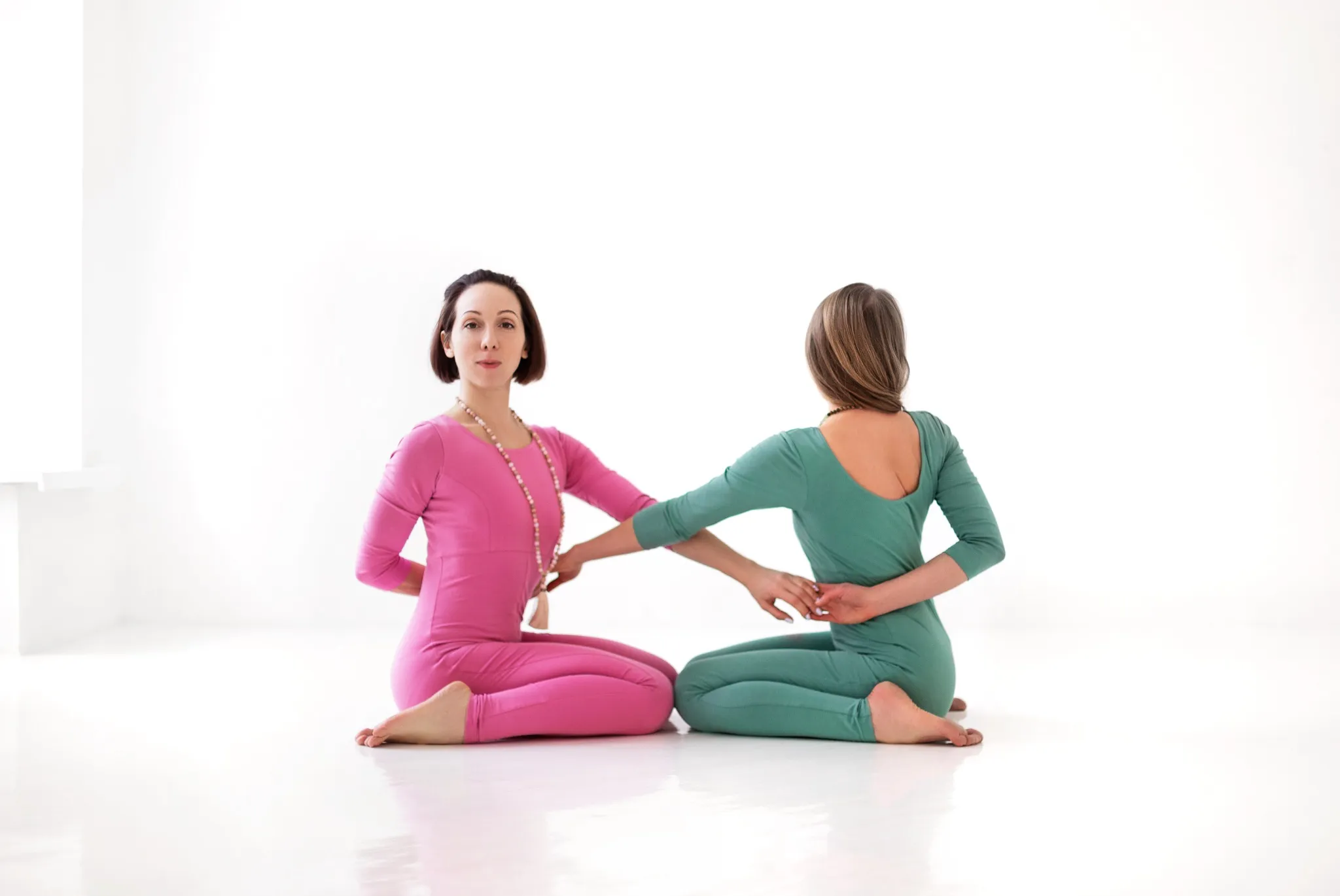
Facing Each Other
- Sit cross-legged, facing your partner, and placing your knees as closely together as you can. You don’t need to press your knees into each other, just have them close or gently touching.
- Inhale deeply and straighten your spine. Use your abdominal muscles to provide support and keep your spine straight.
- Place your right hand on your own left knee while your partner places their right hand on their left knee, twisting gently to the left.
- Reach your left hand to place it behind your back, bracing it against your back or upper thigh. Your partner should do the same.
- You and your partner both reach out with your right hands to grab hold of each other’s left hands.
- Using each other's joined hands as support and bracing, lean into the twist, turning your head over your left shoulder.
- Hold this posture for a few seconds, breathing deeply.
- Release each other's hands and return slowly to your starting position.
- From here, you can repeat the twist in the opposite direction, starting by placing your left hand on your right knee and twisting to your right.
Temple Pose
The temple pose engages your core, including your abs and glutes, and allows you to stretch out your upper body as well.
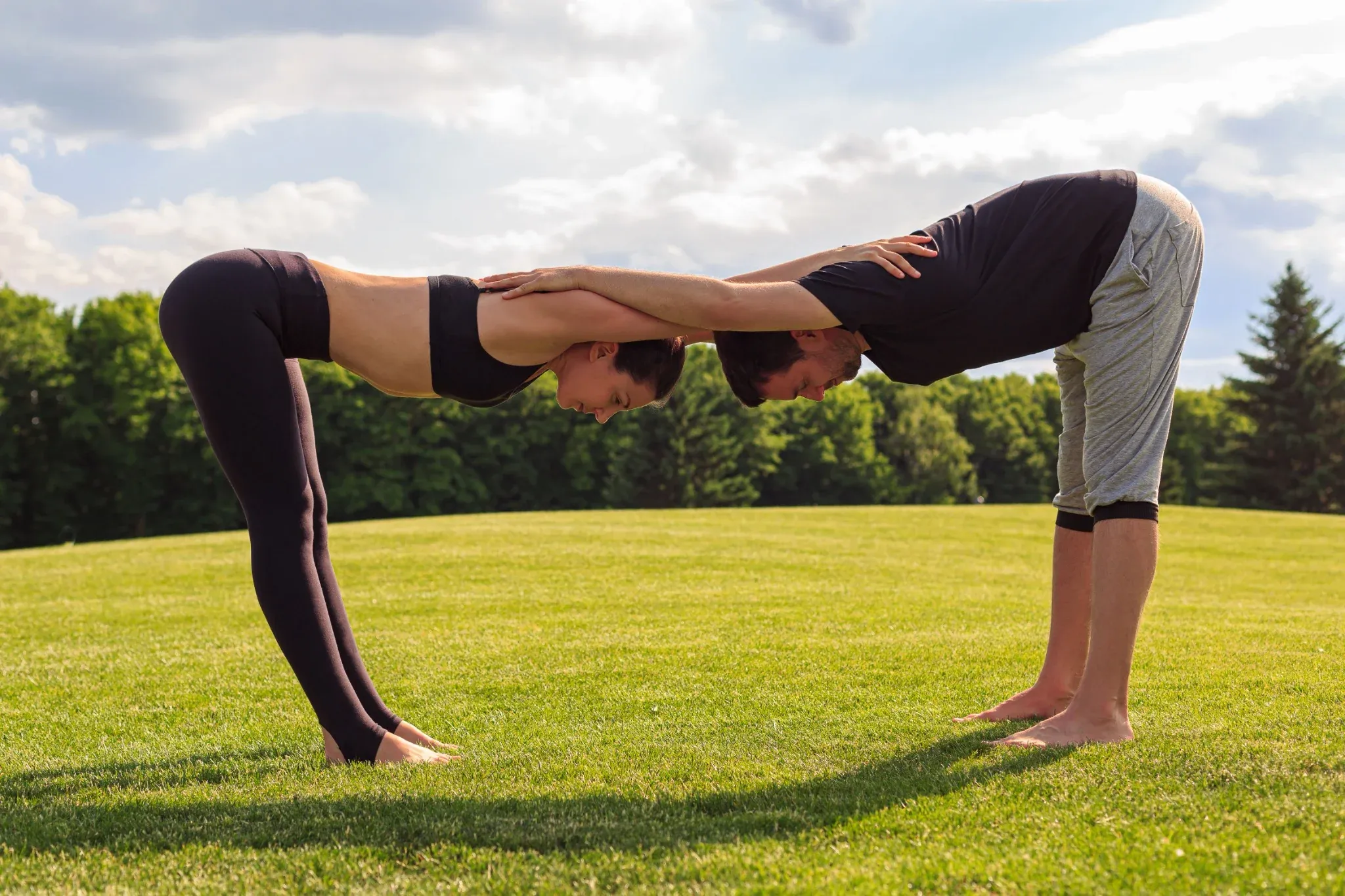
- Stand opposite your partner with your feet hip-width apart and straight forward.
- Raise your arms up above your head, with your palms facing towards your partner. Your partner should do the same.
- Slowly bend forward at the waist, engaging your core to keep both your legs and your back straight.
- As your torso becomes parallel with the ground, make a 90-degree angle at your elbows to meet your partner’s palms with your own. (You may need to adjust your positioning to meet each other in the middle.)
- Using each other for support, hold the position for a few seconds, breathing deeply.
- Push up and straighten your posture, returning to your starting position.
2 Person Yoga Poses: Intermediate Difficulty
This next set of 2 person yoga poses consists of poses that are often done solo, and while they provide a good stretch, they can all pose a bit more of a challenge without a strong sense of balance. Fortunately, doing these poses with a partner allows you to lean on each other for a bit of support, making it a great way to practice and get a feel for the solo posture.
Tree Pose
The tree pose is an excellent way to improve flexibility in your hips, as well as strengthening your feet, your core, and your overall balance. When doing the tree pose with a partner, don’t focus on putting your weight on them, but on supporting them, and trusting them to do the same for you. This allows you to provide each other a strong foundation, just like the roots of a tree.
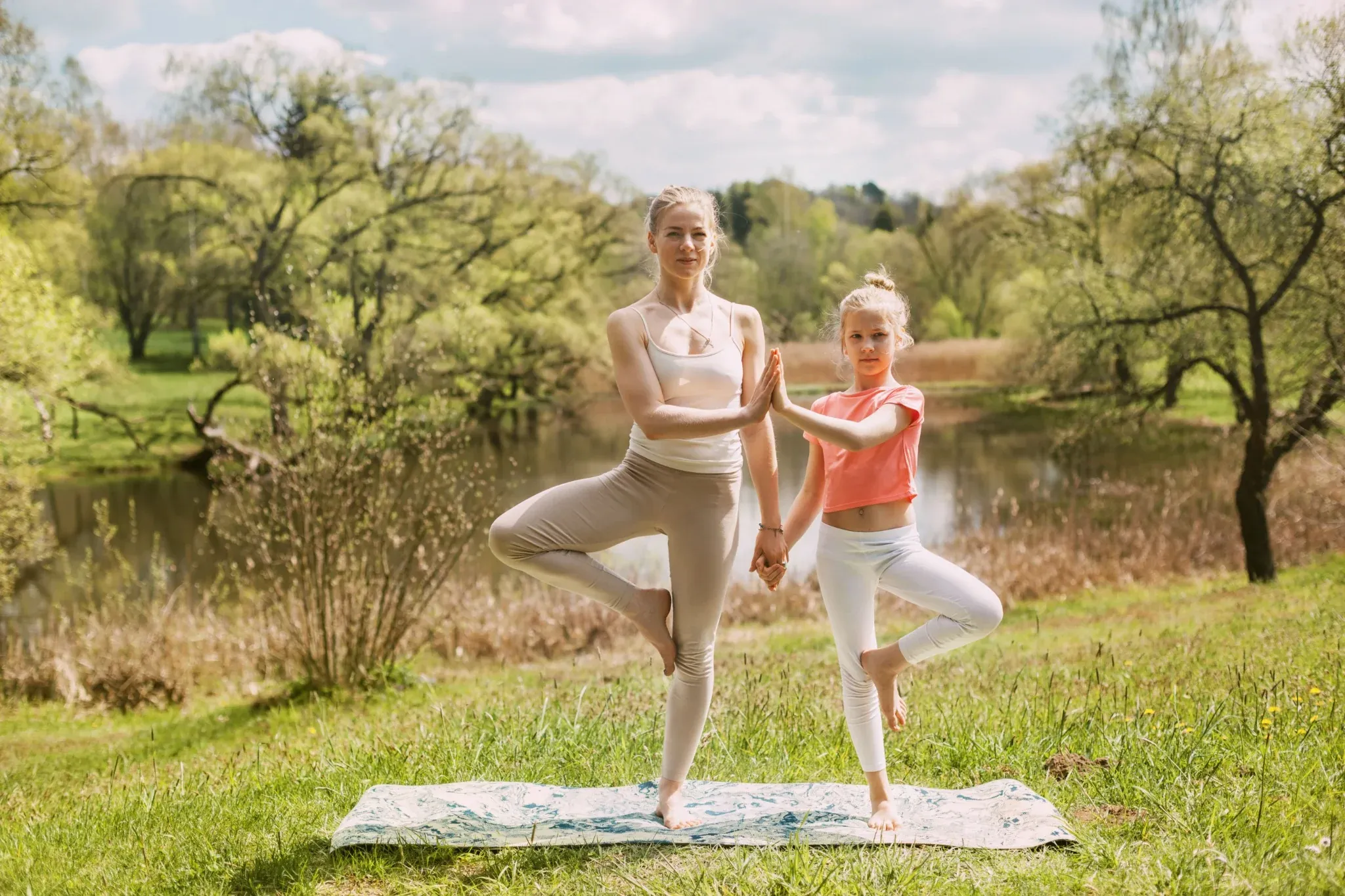
- Stand next to your partner, side to side.
- Place your inner arm behind your partner's back as they do the same for you. In this way you can support each other as you enter the pose.
- Slowly lift your outer leg, steadying your balance as you do so. Point your knee outwards to the side. If you find that you are too close to or far from your partner, take the time to reposition, then repeat until you are comfortable.
- Place the sole of your outer foot against the inner calf of your other leg, just below the knee. If you are feeling flexible and comfortable, you may instead choose to lift the foot higher, placing it above the knee against your inner thigh. (Sometimes it helps to guide your foot upward using your free hand.) Always avoid placing your foot directly at knee level, as the pressure against your knee can cause injury.
- Bring your outer hand inward and press your palm lightly against your partner’s palm.
- Hold your position for a few seconds if you can, then slowly release.
- You can then switch sides to begin the pose again.
Boat Pose
The boat pose traditionally works your core and improves your balance, but like the tree, you can do a partner version of the boat pose to stabilize yourself and practice. Plus, doing the boat pose with a partner forms a unique “W” shape and adds an extra stretch in the arms.
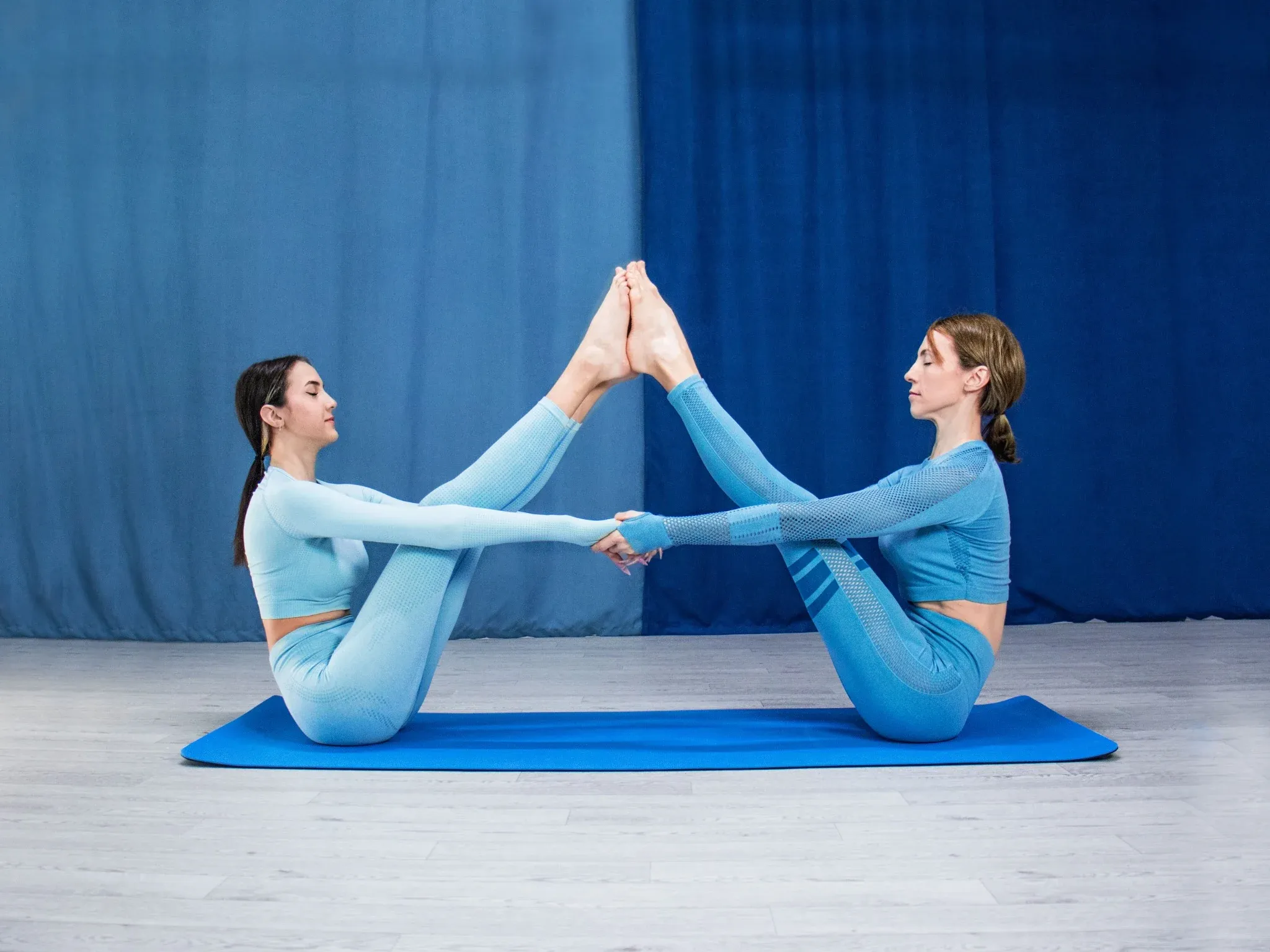
- Sit facing your partner, with your feet flat on the mat in front of you.
- Gently lean back onto your hands for support, then lift the soles of your feet to place them against the soles of your partner’s feet. Focus on driving the motion with your core, instead of rounding your back. To do the pose properly and safely, keep your legs and spine straight.
- Slowly and gently lift your feet together, straightening your legs until the two of you form a “w” shape with your bodies. As you go, you can adjust if needed.
- If you are comfortable and you wish to do so, you can remove your hands from the ground and take each other’s hands one by one, using each other as support and maintaining the balance together.
- Hold your position for a few seconds, breathing deeply, before returning slowly to your starting position.
Dancer Pose
The dancer pose is typically an advanced pose that provides a good stretch in the hips, abs, and especially the quads. While it can still be somewhat challenging in partner yoga, doing it with a second person to help you maintain your balance can help you get comfortable with the stretch and build your confidence and strength.
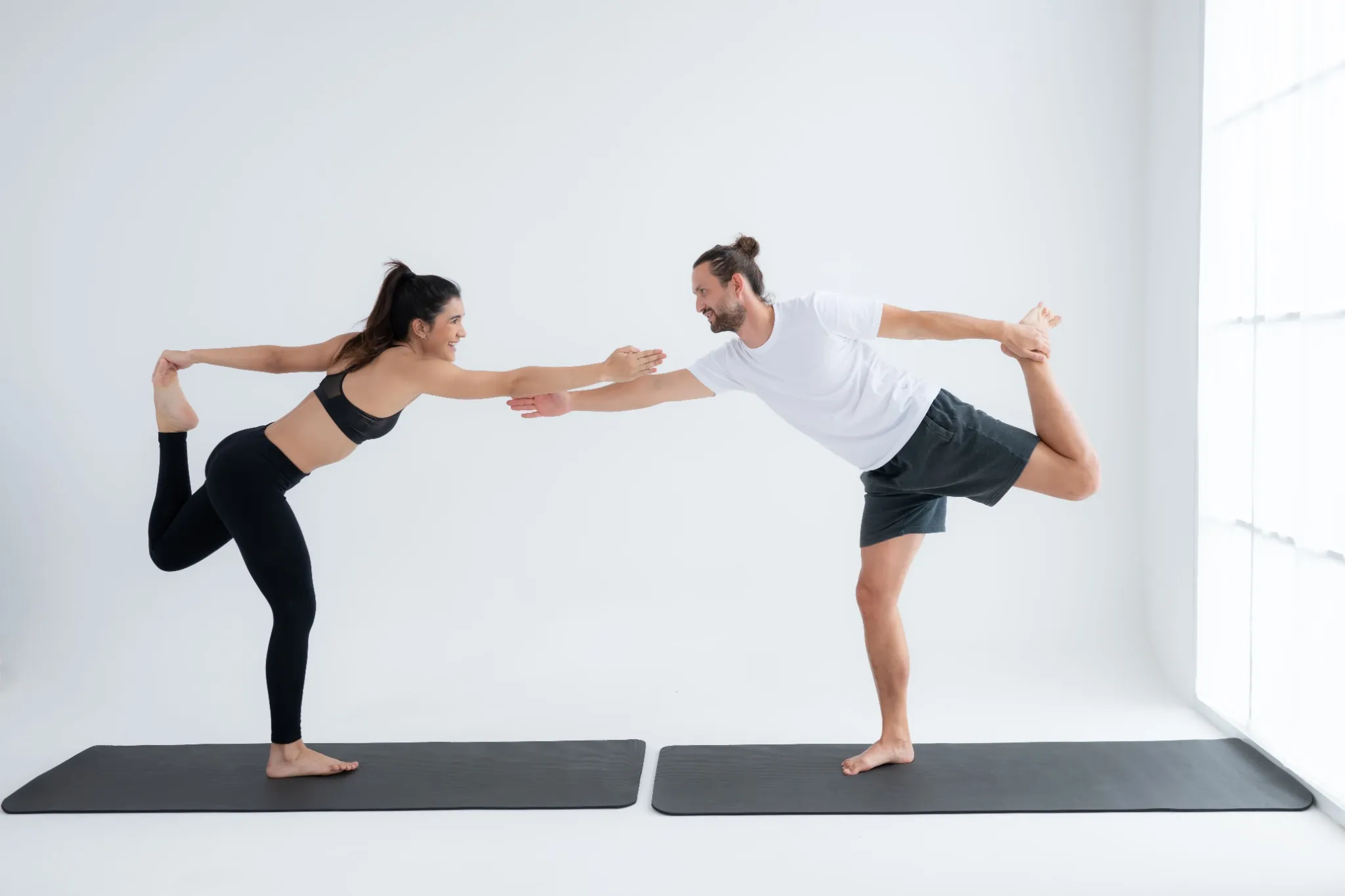
- Standing about an arm's length away from your partner, shift your weight onto your left foot. Raise your right foot off the mat and bend it behind you. Take hold of the top of your right foot with your right hand.
- Raise your left arm up and stretch it towards the sky. Take this opportunity to feel your balance.
- Engage your core and keep it engaged—this is important to support your posture and balance without having to put much weight on your partner.
- Slowly tip forward, pulling your right leg further behind you, and tilting your left arm forward. Your partner should be doing the same across from you.
- As both your left and your right thigh grow parallel with the floor, reach across to gently connect with your partner’s left arm, resting your hand on their shoulder. Do not grip tightly, but rest firmly as they do the same on your shoulder, providing each other with stability as you feel the stretch.
- Hold the position for a few breaths, then slowly lower your left leg, bringing your torso back upright. You may keep your hand on your partner’s arm for comfort, but do not grip onto them or apply pressure, as you don’t want to push or pull them forward and make them lose their balance. Let your hand slide backwards until you are confident in your center of gravity, and return to a standing position.
- You can then repeat the pose, this time shifting your weight onto your right leg and pulling your left foot upward.
2 Person Yoga Poses: Hard Difficulty
This final set of poses, while still more approachable than you may think, can appear quite intimidating. Not only do they work your muscles and test your balance, but also require you to place trust in each other and communicate closely as you rely on each other for support.
In all three of these poses, there will be a partner in a lower position and a partner in an upper position. The partner in the lower position will hold a big responsibility providing foundation and support, while the partner in the upper position will have to rely on their partner’s foundation and their own sense of balance.
Downward Facing Dog Pose
The downward facing dog is a classic yoga pose that stretches several muscles across the body. It can strengthen the arms and hands, as well as the feet and legs, and stretches the spine, calves, shoulders, and more. Doing this pose with a partner can add an additional layer of challenge, requiring balance, stability, and most importantly, trust.
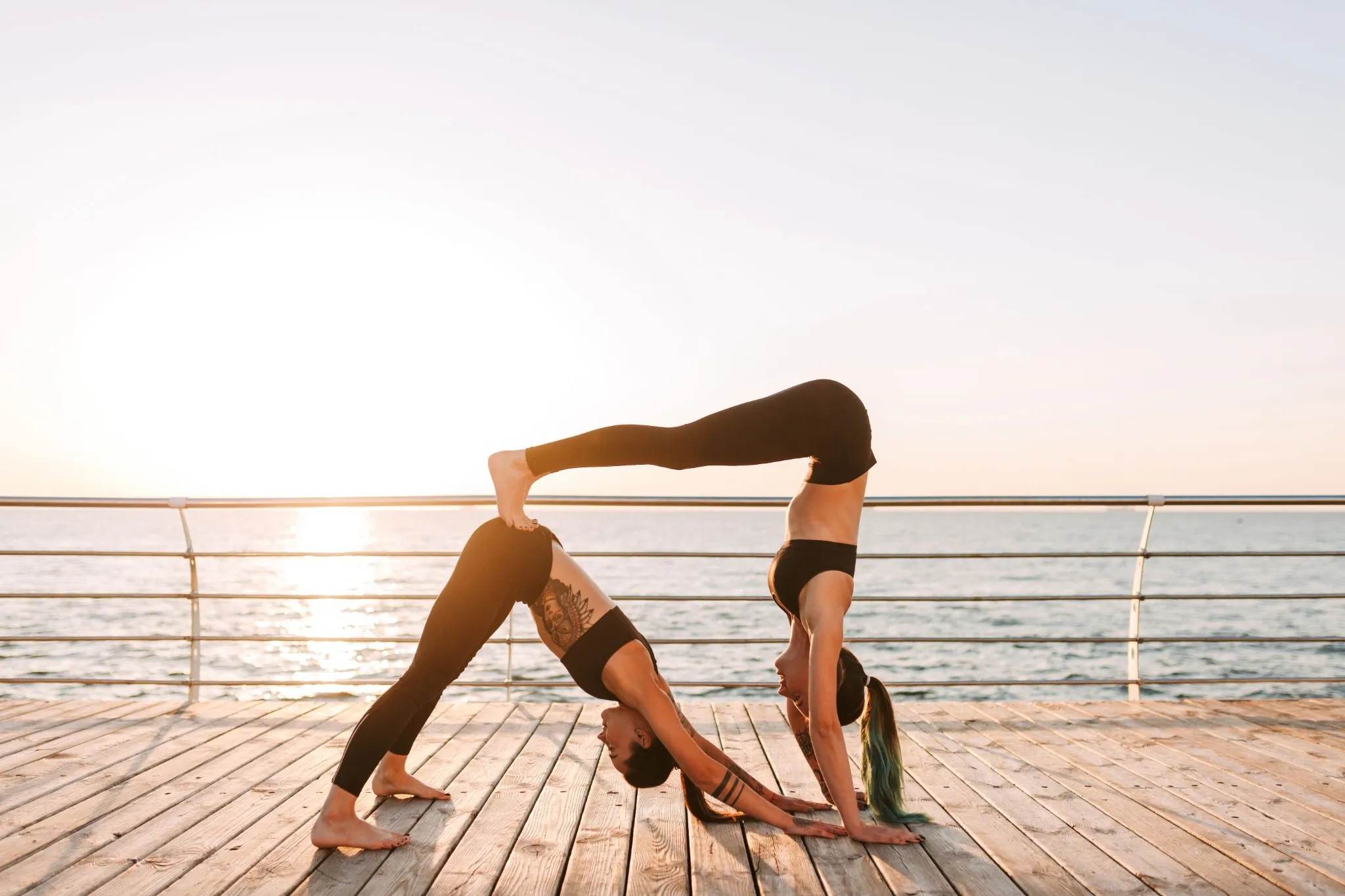
Double Downward Facing Dog: Lower Position
In the lower position, you will do the classic downward facing dog pose to create a foundation for your partner to take the upper position on top.
- Kneel on your hands and knees, making sure both are about shoulder-width apart. Your hands should be just in front of your shoulders, but not far.
- Pull your feet inward to support yourself on your toes as you lift your knees up. Straightening your legs (but not all the way—knees and elbows should both still be slightly bent to avoid overextending), raise your hips upward, forming a triangle shape with your body. Focus on straightening your spine to avoid bending at the lower back.
- Avoid placing too much weight on your wrists. Try to keep even weight between your hands and feet.
- Keep your neck and arms parallel to your spine.
- Feel the stretch, and make sure you are steady before signaling your partner to take their position on top.
- As your partner places their feet on your hips, it can extend the stretch. Relax into it, focusing on maintaining a steady foundation. If you are ever uncomfortable or need to stop, let your partner know so they can safely get down and allow you to regroup.
- If you are both comfortably in position, hold for a few seconds until you are ready to release. Let your partner go first, getting out of your way, then shift your weight back forward until you can place your knees back on the mat.
- From here, you can switch positions if you want to.
Double Downward Facing Dog: Upper Position
The upper position allows you to perform a slight variation on the pose at a different angle. You will need to trust in your partner’s foundation and communicate with them to ensure everyone is comfortable and safe.
- Wait for your partner to finish getting into position, not proceeding until they let you know they are ready.
- Coming around the front of your partner, facing the same direction, take a wide stance with your legs, placing your feet on either side of their hands. Place your hands shoulder width apart, about six to twelve inches in front of your partner’s hands.
- One at a time, bring your feet up to rest just above your partner’s hips, using them as support to straighten your legs (avoiding locking your knees or elbows) and form a triangle position. Focus on straightening your spine to avoid bending at the lower back.
- Avoid placing too much weight on your wrists. Try to keep even weight between your hands and feet.
- Keep your neck and arms parallel to your spine.
- Communicate with your partner and ensure that they are comfortable. If they show discomfort, quickly step down, one foot at a time, to give them room to drop the pose or readjust.
- If both of you are comfortable, lean into the stretch, supporting your weight with both your arms and your legs and hold the position for a few seconds.
- Once you are both ready to finish, step down, one foot at a time, then straighten up to a standing position and step away, giving your partner room to shift forward.
- From here, you can switch positions if you’d like.
Box Pose
The unique partner box pose combines the strengthening power of a plank with a “pike” position (a position where your upper and lower body form an angle) which works muscles in the core. It requires strength, balance, and cooperation, and can take some time to get the hang of. Don’t get discouraged! Keep working at it, and consider trying some other poses to build your strength and confidence if you aren’t able to get it right away.
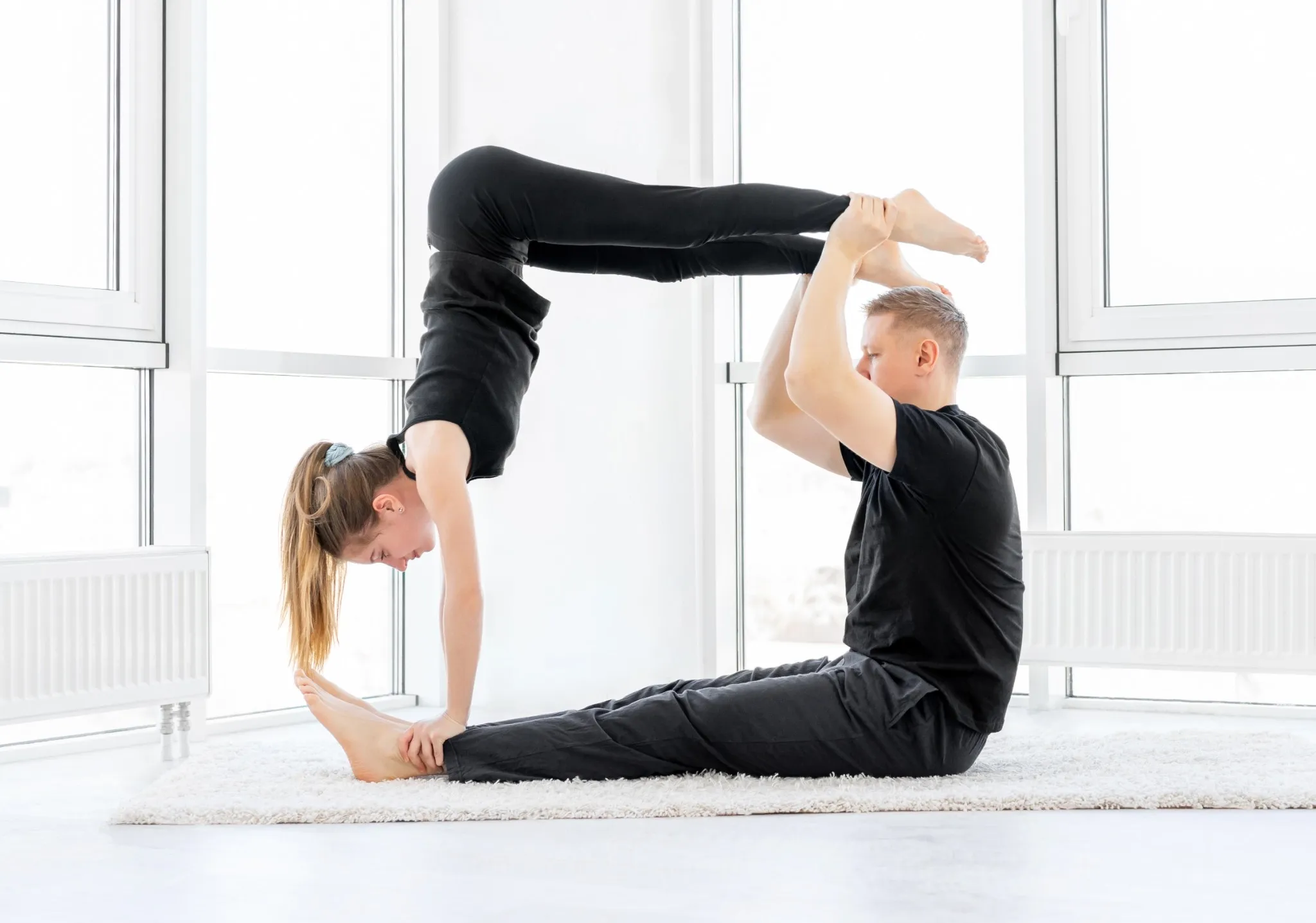
Partner Box Pose: Lower Position
- Lie flat on your back and reach your arms straight upward.
- Your partner will get into a plank position facing in the reverse direction above you. Grab onto their ankles with your hands to provide support, while they grab onto yours.
- Make sure you are both steady and strong, be sure you have a solid grip on your partner so you won’t drop their ankles.
- Using your core, crunch upwards, pushing your body into a sitting up position. Continue to support your partner’s ankles while they form an angle with their body. You should enter into a box position.
- If you are comfortable, you can stay there for a few seconds, remembering to breathe. If at any point you need to let the position go, gently lower your body back down to your starting position—don’t let go of your partner or drop too quickly.
- Once you have returned to starting position, let your partner step off and out of your way before dropping your arms and standing back up.
- If you want, you can switch positions with your partner now.
Partner Box Pose: Upper Position
- Wait for your partner to get comfortably in position.
- Facing in the opposite direction, get into a plank position, starting by taking hold of their ankles, then lifting your feet up one by one so your partner can grab hold of your ankles.
- Take a moment to breathe and get comfortable with the plank position, and then when both you and your partner are ready, work your core to help your partner push you up into a right angle, forming a box position.
- Let your partner know if you need to be lowered down. Otherwise, hold the position for a few breaths before gently lowering yourself back down to your plank position with your partner’s help.
- Once you are finished, step out of your partner’s hands one foot at a time, then stand and move out of the way.
- At this point, you can switch positions if you want to.
Flying Airplane Pose
This pose is a magnificent test of balance, confidence, and trust, and lifts one partner into the air to mimic the sensation of flying. You may also see it referred to as a Superman pose. It can work both partner’s cores, work arm strength, and improve balance, but it’s also a great exercise in communication and teamwork.
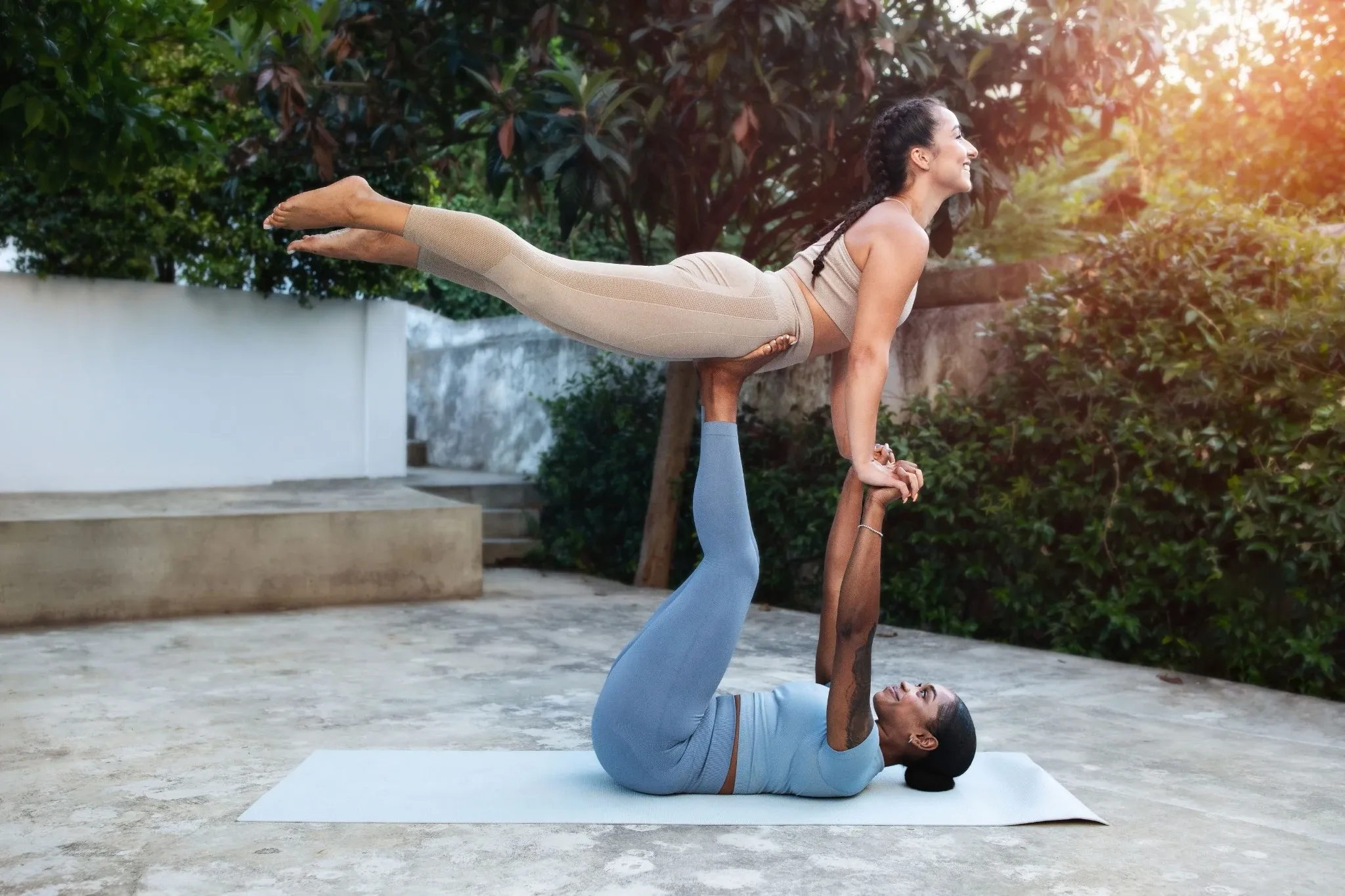
Flying Airplane Pose: Lower Position
- Lie on your back with your knees bent, then lift your legs upward, keeping them bent at an angle.
- As your partner approaches, and with their guidance, place your feet against their pelvis.
- Take both your partner’s hands to provide extra support.
- Your partner will lean inward, while you work on slowly bringing your legs up higher to help lift them off the ground. Take the lift slowly, ensuring that your partner is comfortable and well-supported. If at any point you or your partner feel that you need to leave the position, lower them back down in the direction you lifted them until their feet touch the ground.
- If you are able to, get your partner in the air, near horizontal, only using your arms for support.
- Continue to hold onto your partner’s hands, but if they want to let go, let them do so. However, keep your arms extended upwards to help provide them with a lifeline if they need to catch themselves.
- When your partner is ready to come down, take hold of their hands and gently lower them to the ground.
- Take a few minutes to breathe and reset. Afterwards, you can switch positions if you want to.
Flying Airplane Pose: Upper Position
- Wait for your partner to get comfortably in position. Once they are ready, you can join them, helping guide their feet squarely onto your pelvis.
- Once you are positioned, lean forward to take your partner’s hands, bracing against them for support as you slowly lift your legs off the ground.
- You don’t have to go straight into a horizontal position right away. You may want to practice lifting your legs up and down for a minute to build your confidence and ensure that you are positioned properly against your partner’s feet.
- If you are in a position where you feel comfortable doing so, you can let go of your partner’s hands. First, check to make sure you feel good and your balance is steady. If so, you can slowly and carefully stretch your arms out behind you, maintaining your center of gravity in your core and stretching your arms, legs, and chest.
- Once you are ready to return to the Earth, take hold of your partner’s hands and work with them to slowly lower your legs back down until your feet are touching the ground again.
Recent Posts
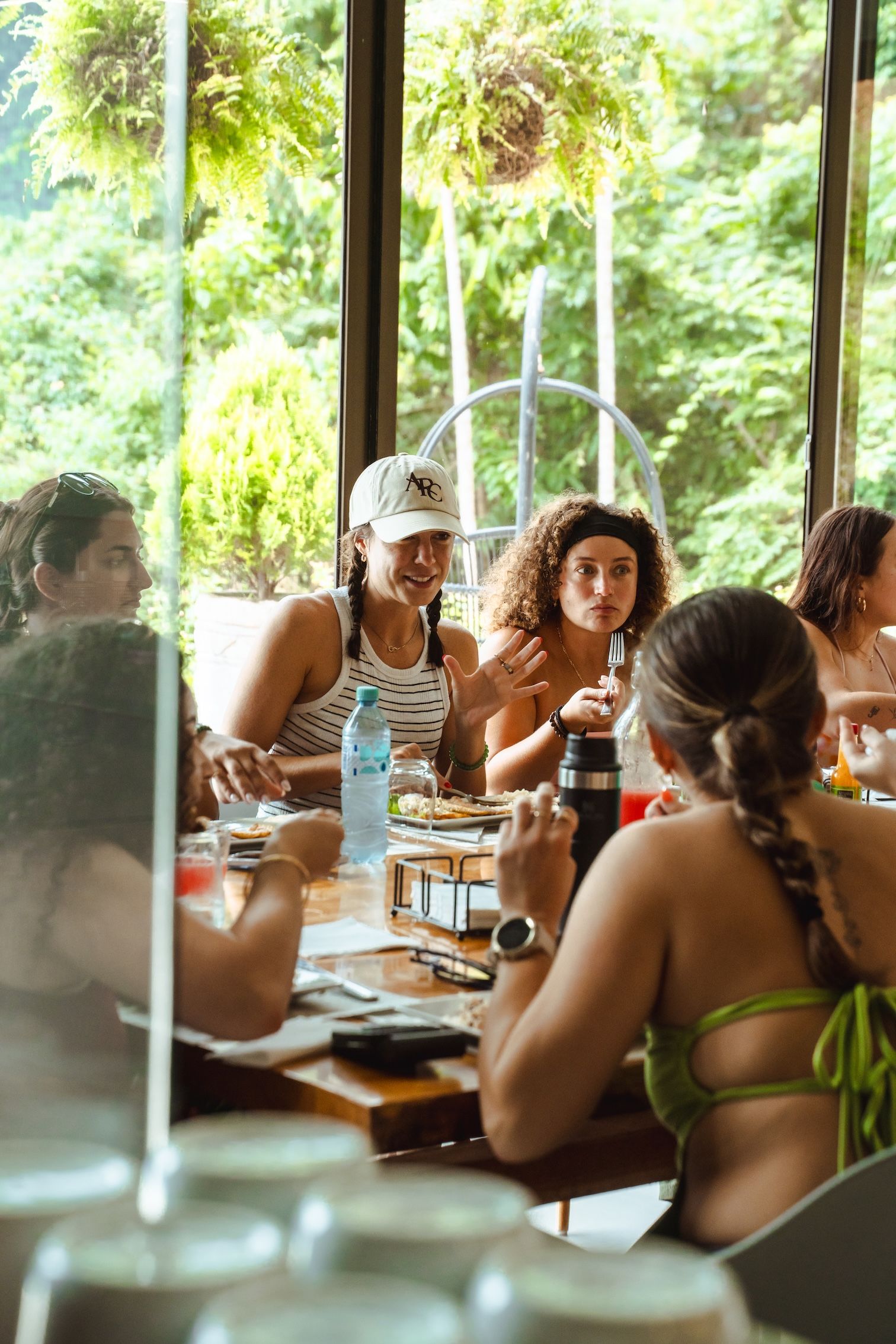
A Retreat for Everyone: Exploring Different Types of Retreats
Unpacking 4 major types of retreats, what to expect, & tips to make it a memorable experience.
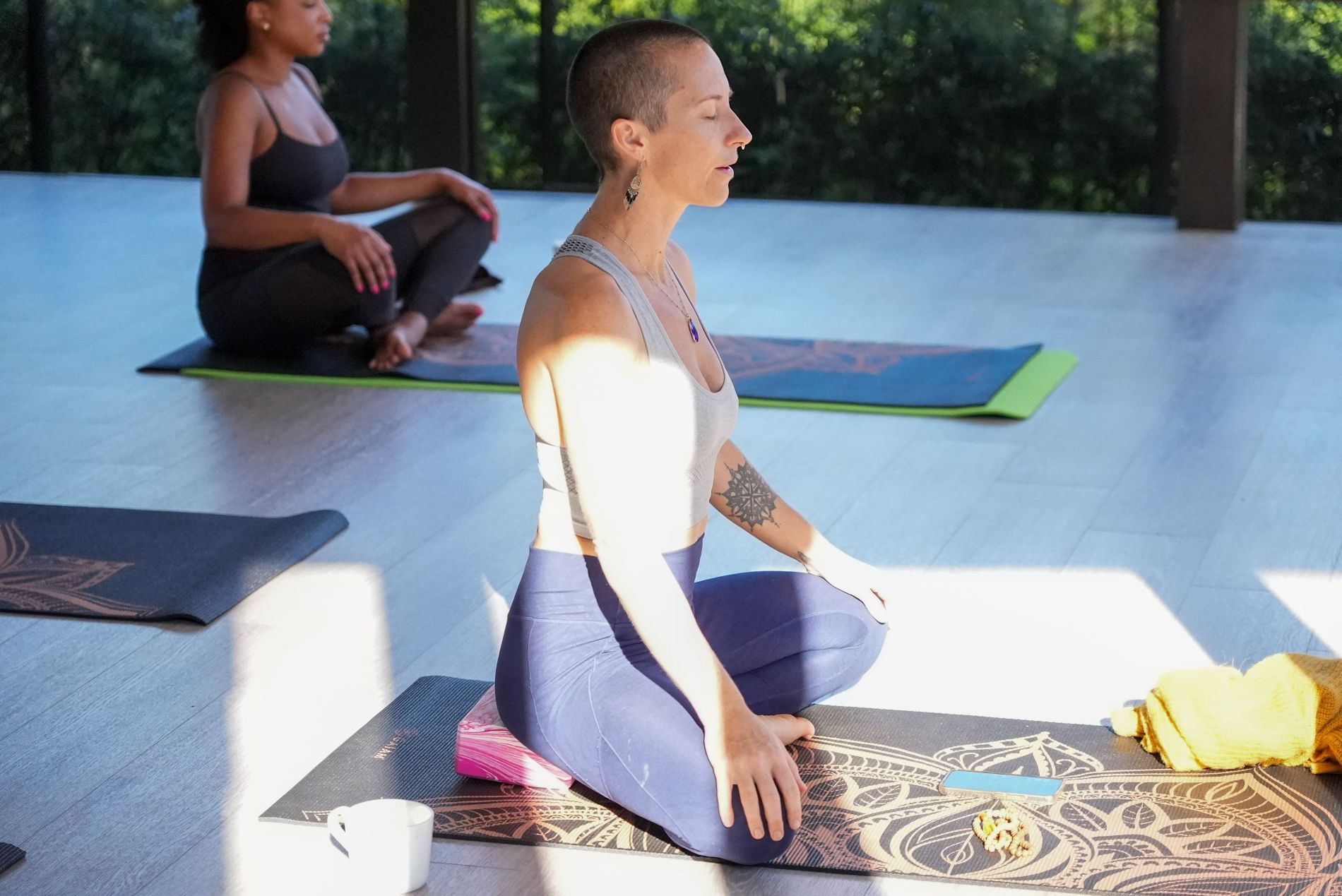
What Does It Mean to Align Your Chakras?
An introduction to aligning chakras: meaning, history, & benefits.
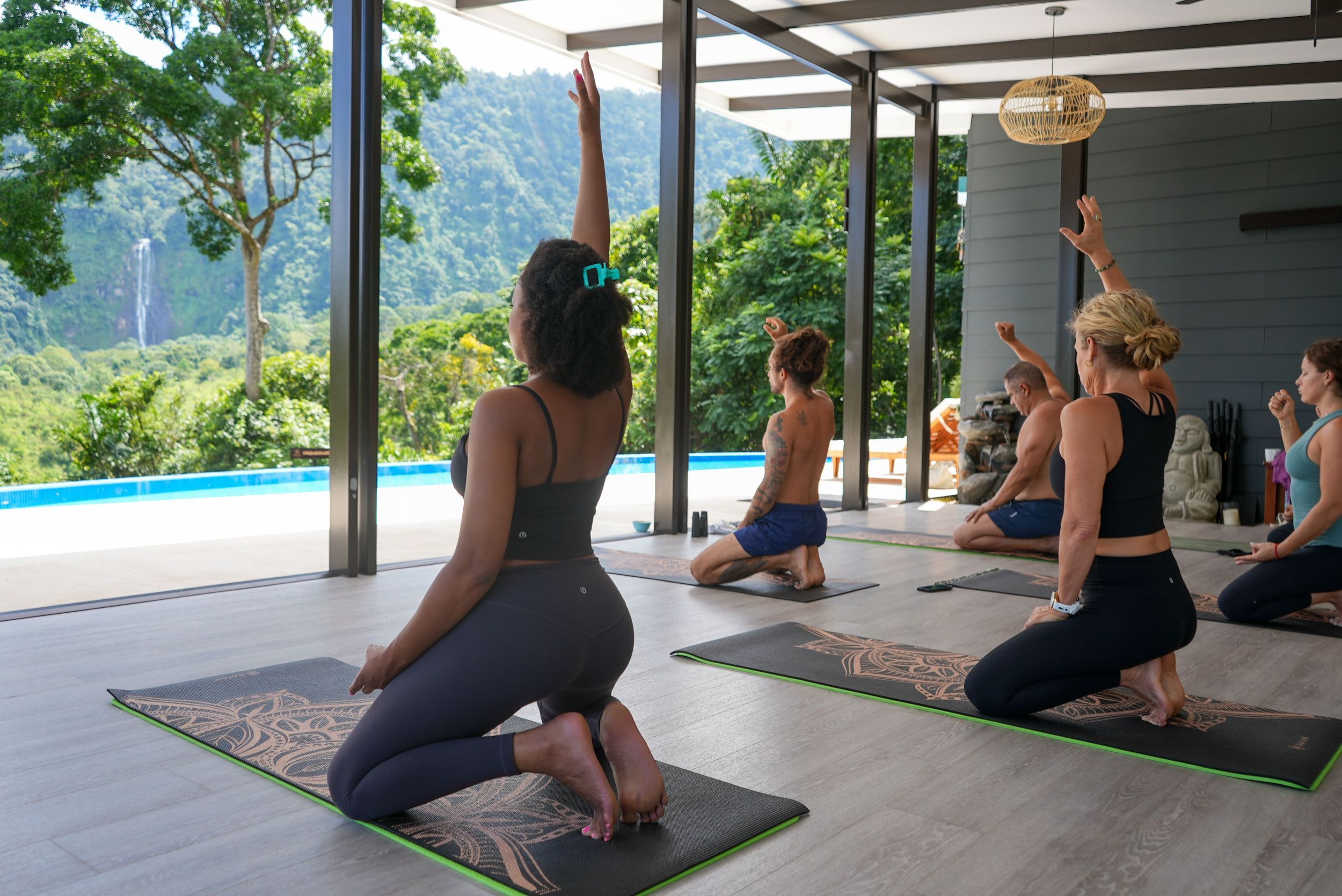
The Eight Limbs of Yoga: Practicing Yoga Every Day
Exploring the eight limbs of yoga, as found in the yoga sutras, and how to apply them to your practice.
Deepen Your Practice in Costa Rica
With supportive guidance, modern amenities, and a serene jungle setting, Vajra Jahra Retreat Center offers the perfect environment to focus, grow, and transform.
Get Started Get Started
Get Started